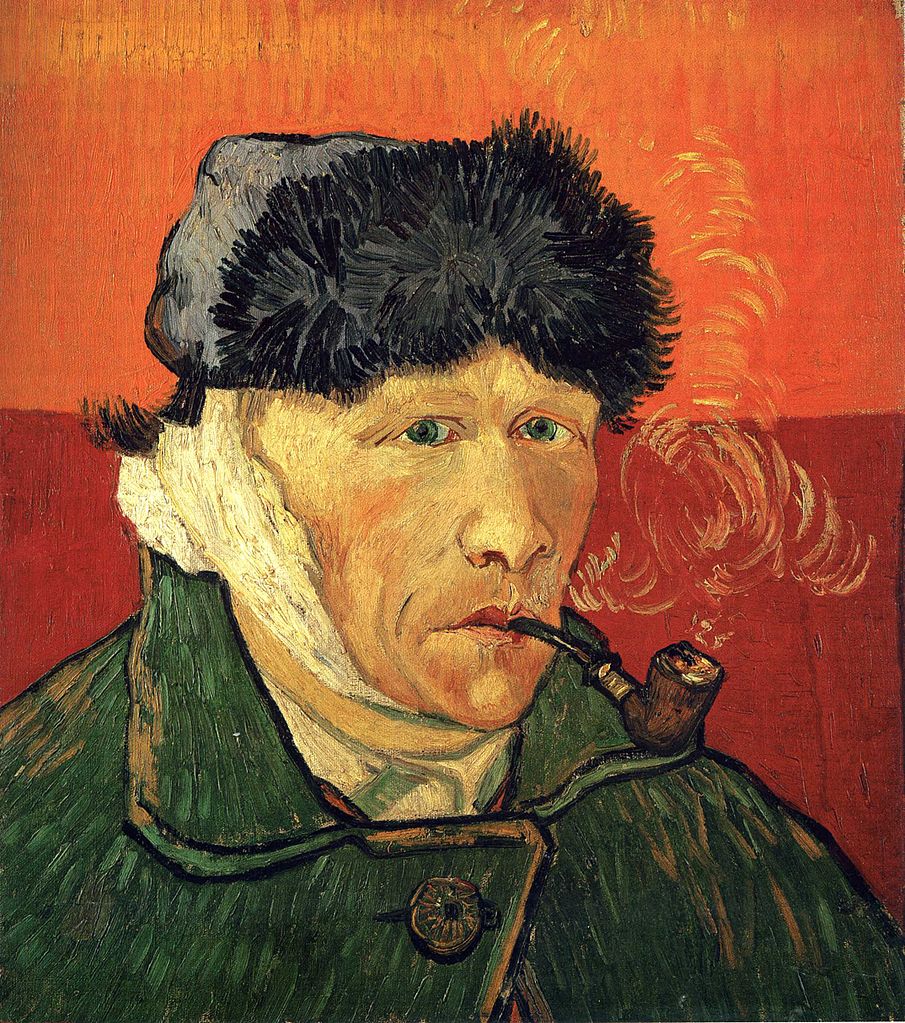Vincent Van Gogh was an admired artist, who was also a troubled and “tortured genius.” His artwork, Starry Night, Bedroom in Arles, and many others have earned him fame and recognition as one of the greatest artists of his time. But what many remember most about this artist is the story of his severed ear. Although his art is exemplary, his struggle with mental health and self-harm is admirable. His struggle was overlooked due to his incredible talent. He was successful as an art dealer, but as an artist, he had to prove himself with the headquarters of international art dealers, Gopil & Cie. During his lifetime, Van Gogh was the poster boy for the image of starving artist. His artwork was not recognized until much later in his career, which could have been a leading cause of his major depression and anxiety.1
Van Gogh, born in the Netherlands, decided to start his career in Paris in the 1880s, where many of the age’s great artists also resided. He believed he could get recognition for his pieces through his younger brother, Theo, who made his living as an art dealer. His brother introduced him to many artists, including Georges Seaurat, Camille Pisatto, and Paul Gauguin. Upon meeting these successful artists, Van Gogh was greatly inspired by their work and began creating his own artistic style, beginning in 1883. Later the same year, Van Gogh rented a small house in Arles, in the south of France. Paul Gauguin and Van Gogh became close friends and later roommates. They consistently bounced ideas off of each other and created a strong friendship.2

Like many friendships, theirs was rocky, and they found themselves drifting apart. Gauguin had moved on to a different artistic style and was exploring other ideas. Van Gogh at the time, had been reciprocating signs of depression and mental health issues, but at the time, these symptoms were considered normal. When Gauguin decided to explore other art spectrums, it involved moving out of the house he and Van Gogh shared. He broke the news to his roommate about his intentions, and this evidently this made Van Gogh go over the edge. He did not take the news lightly and both men began verbally arguing. Van Gogh had disappeared for a few hours and when he returned to confront Gauguin, he had a razor blade in hand threatening to hurt Gauguin.3
During the confrontation, however, Van Gogh was hesitant to hurt his friend and decided to turn the blade on himself and completely cut off his ear. Gauguin left him bleeding and alone. Van Gogh bandaged his head and began drowning himself in alcohol. During this episode, he walked out of his home and into the streets where he found a prostitute. The ear that he had severed off of himself had been neatly wrapped in a cloth; since Van Gogh was still heavily intoxicated, he decided to present this token to the prostitute. Patiently, she ran off and alerted the police about her encounter and they immediately rushed to his home.4
Shortly before Christmas Eve, Van Gogh was found by police in his bed, partially conscious and with major blood loss. Authorities rushed him to the hospital where he surprisingly recovered. Meanwhile, Gauguin was brought into questioning, but gave no testimony on the incident. It was believed that Van Gogh had suffered a severe mental breakdown long before he had severed his ear, but that this created a ripple effect that led to lunacy. The real reason behind the infamous Van Gogh ear-cutting may never be known; Gauguin had promised Van Gogh a pact of silence on the situation in letters that they supposedly exchanged. 5

After the incident, Van Gogh was admitted into a psychiatric facility in hopes of recovering mentally and physically. The dramatic change was not helpful for such a troubled artist, and in July of 1890, Vincent Van Gogh ended his life with a revolver. Before his suicide, however, he created a very iconic painting, Self Portrait with Bandaged Ear 1889. Van Gogh intended to persuade his doctors that he was perfectly able to continue working and creating art by creating this self portrait. He presented his piece, leaving a trail of wonder for his supporters as to why he included certain details in this particular piece, mainly because he continued to paint himself in the same yellow house he and Gauguin shared. Doctors overlooked these details and allowed Van Gogh to leave the facility.6
The epidemy of many artists like Van Gogh is often associated with mental instability, drug use, and alcohol abuse. Van Gogh had an array of medical issues that were tied back to his coping mechanisms (alcohol abuse), and as a result, many did not understand the struggles he faced and degraded him as a person while idolizing his artistic talent. As said before, the real reason behind his mutilated ear will be unclear, but his work and talent will continue to inspire and educate.
- Adam Gopnik, “Van Gogh’s Ear,” The New Yorker, Literature Resource Center (January 4, 2010): 48. ↵
- “Who Really Cut Off Van Gogh’s Ear?” Weekend All Things Considered, Literature Resource Center, (May 2010). ↵
- “Who Really Cut Off Van Gogh’s Ear?” Weekend All Things Considered, Literature Resource Center, (May 2010). ↵
- Belinda Thomson, “Comparing lives: issues of balance in biographical writing,” Literature Resource Center, French Politics, Culture and Society 24, no. 2 (2006): 60. ↵
- Tim Suermondt, “All the Answers.” Literature Resource Ceter, Prairie Schooner 85, no.3 (2011): 47. ↵
- Tim Suermondt, “All the Answers,” Literature Resource Center, Prairie Schooner 85, no. 3 (2011): 47. ↵



170 comments
Noah Bolhuis
It is so sad to see someone with mental disability not be helped until near death because of his artistic ability. People with true talents are often seen as what they can do, rather that who they are and the struggles that they face. His friend and roommate should bear no responsibility for Gogh’s actions. Today, it is common knowledge that Van Gogh suffered with mental disability, and cut off his ear. However, the extent to his struggles was represented in this article.
Daniela Martinez
This article is very interesting. As a person who loves art, I’ve always wondered what the real reason behind Van Goghs action to cutting his ear off. Yet after reading this article and many others, it seems that there will never a be a d.efinite answer. However, by learning more about Van Gogh’s background and life one can sort of understand his actions, Van Gogh regardless was one of the most astounding artists of his time. I think it is interesting that many of artist are truly great at their art but fail to receive the help they need, resulting in the early death of many talented souls.
Nathan Hartley
I know almost nothing about, so when I read this article and it explained the struggles behind the painting that some people never see, it changed my view of his art. I think he is a very gifted artist even if he was discovered until later in his life. I think the article was very descriptive and I really enjoyed the background information provided to give more depth to the paintings.
Dylan Coons
Although it’s a giant stereotype to be America and love impressionism, that never stopped me from admiring Van Goughs. Despite being familiar with his work, I have never actually known much about his life. Especially the story about how he cut off his ear. This is a great article and is filled with interesting information about Van Gough’sm life, like information on his friend/ roommate, Gauguin.
Sabrina Hsu
I’ve always known about Van Gogh cutting off his ear but I didn’t know this was the real story. The story I had always heard was that he got his heart broken by a woman and was so sad that he cut his ear off and sent it to her. I’m glad I now know what actually happened and that what I knew was way off. Nevertheless, it’s really sad what Van Gogh went through and I had no idea he had mental illness issues or that he dealt alcohol abuse. I really enjoyed how much I learned from this article and am glad I read it.
Daniel Linstead
I actually learn’t a brief thing about this in one of my classes this week. However, reading this made it more clearer and gave me a better understanding of what my professor was saying in class. I like this article and how it was delivered. Not a huge fan of art but I did enjoy reading this article.
Luke Lopez
What I knew prior to reading this article is that Van Gogh had cut off his own ear, but what I found surprising is that he killed himself. I did not have any idea that Van Gogh was mentally unstable and was a danger to himself and others around him. I also did not know that Van Gogh struggled with alcohol abuse.
Crystal Baeza
It’s saddening to hear about many loved artists suffer from drugs or alcohol abuse and it takes a tole on themselves. Maybe if someone had noticed Van Gogh’s illness he could created more artwork that mesmerized the world. It’s insane how he literally chopped of his own ear and til this day no one know really why. I hope artists with who suffer with mental illness can get the help they need from others rather than drugs or alcohol that numb the pain for only a few hours.
Steven Hale
I previously knew Van Gogh cut off his own ear but I did not know about his suicide. The link between artistry and mental health is curious, but I wonder if that correlation has more to do with what artists go through than the artistry itself. It could not have been easy to move to a new country and rely on a passion that does not offer a consistent or predictable income.
Enrique Segovia
After hearing numerous different stories about why Vincent Van Gogh, I finally know the true anecdote of the events preceding his self-mutilation. As the author declared, the real reason behind Van Gogh cutting his ear off with a razor blade is still undiscovered. Nonetheless, reading this article was very interesting since I did not know much about Van Gogh’s life. I am familiar with a few of his paintings, and I knew he mastered the art of self-portrait, but I did not know about his personal life, nor did I know he was Gauguin’s roommate. Probably, Gauguin knew what was messing with Van Gogh’s, but we will never know the true reason behind his mutilated ear.